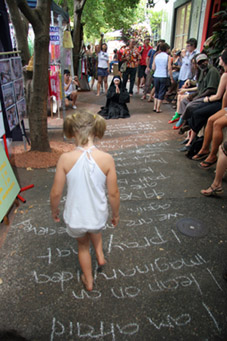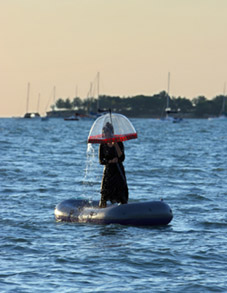at play in public space
allison gray encounters interpositions at the darwin festival

A Prayer, Jill Orr, Interpositions
photo Fiona Morrison
A Prayer, Jill Orr, Interpositions
INTERPOSITIONS WAS STAGED AS PART OF THE DARWIN FESTIVAL PROGRAM BY 24HR ART AT VARIOUS PUBLIC LOCATIONS AROUND THE CITY IN A WEEK LONG SERIES OF ROVING INTERVENTIONIST PERFORMANCES. FOCUSED ON THE PERFORMING ARTS AS A CONDUIT FOR INTERCULTURAL DIALOGUE, COLLABORATION, AUDIENCE PARTICIPATION AND REACTION, THE EVENT FEATURED TEN ARTISTS: JILL ORR, ANN FUATA, ASH KEATING, JASON KEATS, HAYLEY WEST AND DANIELLE FREAKLEY FROM AUSTRALIA, AND FROM SINGAPORE JULIANA YASIN, KHAIRUDDIN HORI, RIZMAN PUTRA AND LYNN LU.
Jill Orr appeared in a performance entitled A Prayer wearing a nun’s habit. For much of the performance she was on hands and knees scribing on hard pavement, beginning with “I stand on Larrakia land. I pray for the children.” Orr continued with a functional but loose, organic sway and at times stood, gathered herself and then returned again to her cathartic writing. At moments she appeared struck somehow, like a savant illumine in a cinematic pose. Much of Orr’s oeuvre can be characterised as enactment of iconic still imagery. This performance was located in the Darwin weekend markets where the tightly packed stalls created a cloistered tunnel. The stalls’ canvas walls produced dramatic flat planes of light and dark and elsewhere dappled sunlight streamed down on the achingly spiritual scene. In this way the performance related to Orr’s larger body of work. In evidence as early as 1979, in Lunch with Birds where her figure became a vessel, covered in loaves and small fish, Orr is often associated, as performance theorist Anne Marsh has pointed out, with images of sacrifice and endurance.
More typically, the nun is cast by Orr as an institutional character, pertinent in these times of renewed governmental vigour, some say a new colonialism. In this way the performance spoke equally to the past, present and future. On the one hand, Orr’s persona stands in for the ‘alien other.’ This is convincingly conveyed—her dissociation with place is apparent in the prickly contrast of the black cloth and stockings against the pounding heat of the sun. On the other hand, the religious habit does not appear as divisive as it once might have. No longer are conclusions cast in black and white or good versus evil. Rather, the religious figure is read as a universal character—we are all implicated. Orr confirms this: in her original design she may have taken the habit off, but ultimately didn’t need to.
The words chalked on the marketplace pavement were given another life by a passer-by who read them aloud. This anonymous, Indigenous gentleman, old and weathered, didn’t just say them, but theatrically delivered them, giving the performance further resonance, complexity and a sense of complicity. Shortly thereafter another Aboriginal man contributed his own aptly contradictory utterances: “You’re evil, sister” and “We love you, sister.”
The words of a guest speaker at another Darwin Festival event resonated. Gary Lee in his Larrakia welcome to country for the National Aboriginal Torres Strait Islander Award exhibition affirmed that “The federal invasion into Aboriginal communities and the control, disruption and uncertainty foisted upon us, to our lives, should be condemned for what it is—a colonial style land-grab—in the name of protecting Aboriginal children.”

Lynn Lu, Interpositions
photo Fiona Morrison
Lynn Lu, Interpositions
A Punch in the Gut: Experiential Knowledge, Empathy and Performance Art is the title of a doctoral thesis by Singaporean artist Lynn Lu currently studying in Japan. The title provides entry into her Interpositions work and a performance practice that she has built extensively over the past 13 years in the United States, North and Southeast Asia and Europe. As Lu affirms, “there are some things in this world that you can only know through personal experience and this kind of knowledge is very different to knowledge you receive from others, knowledge you accept on faith or which is based on logic or inference.”
One sunset on the azure Arafura Sea, Lu rows a rickety rubber boat far from the Darwin shoreline. With increasing distance her figure becomes a silhouette. What occurs is absurd: kneeling in the boat, she pops up an umbrella and a summer rain falls. Elsewhere it is sunny. The rain falls from her umbrella to create a tinkling structure of entrapment. After a time the boat sinks. Lu disappears, consumed by the sea. She has been, in her own words, “dunked” and needs to swim to shore.
Compared with Lu’s previous performances, this can be considered a diaristic piece which the artist has jokingly labelled her “love series”—having recently fallen out of it. According to Lu the performance draws on a strong image that occurred to her from a moment towards the end of her relationship, of being in a private rainstorm and how absurd it is to somebody watching from the outside in apparent sunshine. In this way the location of Darwin brought to bear other associations not necessarily intended by Lu. The Darwin shoreline as Australia’s most northern waters is a deeply ambiguous and politicised space. According to locals on the shoreline, unaware of Lu’s personal metaphor, the performance was cast in more political terms, of being witness to a troubled figure at sea, but not necessarily able to do anything about it.
Rizman Putra’s explosive energy and hilarity was contagious and also rooted in experience. He dressed in various costumes, but most often wore a cute mask, made in the form of a dog’s head, and a full-body lycra suit. The energy with which he trashed plastic flowers against an asphalt surface, chucked a total, full-body tanty, rolled around the floor, four legs bent like a dog, was laudable. Putra is determined to create “a space in which to be silly” and to enact a cliché—“really bad performance.” In general terms the audience followed his chaos assisted through much of the performance with ‘signs’, a performance approach made famous by Bob Dylan and now itself clichéd through appropriation in music videos. Rizman fashioned an acute wordplay on tropes like ‘rock and roll’ and ‘heavy metal’ to a soundtrack of mixes including Elvis Presley and 80s rock band Survivor. Quotation from the genres of poetry, photography, video, music, burlesque and dance were given an airing in Rizman’s tight if chaotic performance.
Singapore artist Khairuddin Hori’s stark yet teasing, porn-like routine was consummately staged in the unsoiled environment of a well chosen sparkling laundromat. Melbourne’s Danielle Freakley engaged her audience with the Quote Generator in which language is stolen, concentrated and overdramatised with well-known quotations assimilated into everyday life to remarkable effect. While Darwin’s Hayley West invited audiences to her market stall for complimentary card or letter writing on their behalf or to exchange small personal items, Ann Fuata focused on the personal and rituals of hair and identity.
A shared strategy was employed across Interpositions, a casual sense of play that was engaging and participatory.
24 HR Art, interpositions, Darwin Festival, various locations, Aug 11-18;
http://interpositions.blogspot.com/; http://www.youtube.com/24HRArt
RealTime issue #81 Oct-Nov 2007 pg. 40






